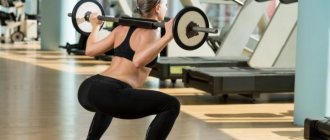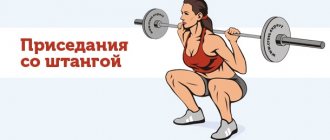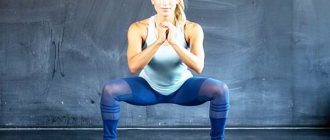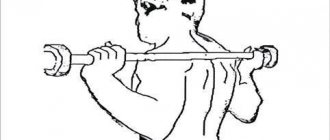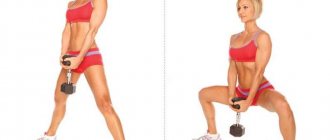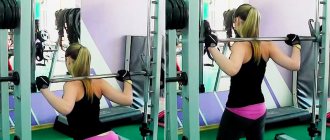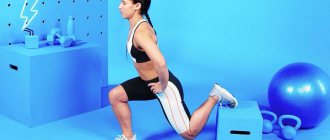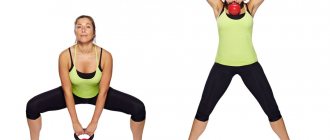Barbell squats are the main tool in building powerful, bulky leg muscles. This exercise is multifaceted not only from the point of view of variability of execution (classical, frontal, in the Smith machine, with dumbbells, plie, and so on), but also from the point of view of the amplitude of movement. Most of the controversy is about deep squats. Their supporters talk about more detailed development of the leg muscles, associating it with a greater amplitude of movement, while opponents argue that this type of squats puts more stress on the knees, and, therefore, is more dangerous. Where is the truth? Let's try to figure it out.
What muscles work
A deep squat with a barbell differs from classic squats only in the amplitude of movement, so it cannot be said that fundamentally different muscle groups are involved. The only difference is the number of muscle fibers worked.
So, when performing deep squats with a barbell, they work:
- Quadriceps;
- Gluteus maximus muscles;
- Adductor muscles;
- Calf muscles;
- Back muscles (especially the lower back), which act as stabilizers;
- The abdominal muscles, like the back muscles, act as stabilizers.
Extensor muscle volume increases regardless of squat depth
The volumes of the knee extensor muscles increased significantly in both groups, the difference between the groups was not significant (4.9% in FST and 4.7% in HST). However, one of the quadriceps bundles, the rectus femoris muscle, showed an increase of less than 1%.
(This is the same muscle that raises the hip when walking, anatomically this movement is called hip flexion). Low height can be explained by the peculiarity of the attachment of the rectus muscle; when performing a squat, it simultaneously contracts and stretches, which reduces the degree of its dynamic work. Working less means developing less.
Advantages and disadvantages
Opponents of deep squats talk about their negative impact on the knee joints and, as a consequence, an increased risk of diseases such as osteoarthritis and osteochondrosis.
However, studies conducted in 2013 showed that in the lower phase of squats, when the pelvis drops below the level of the knees, the load on the anterior cruciate ligament of the knee not only does not increase, but, on the contrary, becomes less. At the same time, it was found that the knee joint experiences the greatest loads during shallow squats, when in the negative phase of movement the pelvis does not fall below the level of the knee joints.
Due to the long range of motion, deep squats use more muscle fibers than partial squats. This is especially true for the quadriceps and gluteus maximus muscles, since they are the ones that receive the greatest stretch at the bottom.
Thus, among the main advantages of a deep squat are:
- better training of target muscle groups;
- and less harm to the knee joints.
Perhaps the main disadvantage of this exercise, many will call the inability to work with the same weights as with partial squats. Indeed, if you squat with a barbell weight of 150 kilograms in an incomplete amplitude, then with deep squats you are unlikely to be able to squeeze the same weight from the bottom point. However, it is important to understand that it is better to squat well with a weight of 120 kilograms than to stroke your ego with a squat with a barbell weighing 150, thereby harming your knees.
Work of muscles and joints
When performing any squats, in particular deep ones, almost all muscles are activated, so the squat is one of the main exercises in the training of athletes. But, if in bodybuilding squats the main load can be concentrated in the quadriceps, then the deep squat actively includes the back, back of the thigh and buttocks. In the lower phase of the range of motion, the buttocks receive a colossal load, but, nevertheless, this type of squats is not suitable for girls, since, in addition to the buttocks, such a squat stimulates hypertrophy of all other muscles that girls should not hypertrophy.
It works a lot of joints; squats, in general, are a multi-joint basic exercise, but in this case, since you squat deeply, at the bottom point your butt “nods down,” which creates an excessive load on the lumbar spine. That is why you should go down slowly and under control, and not drop the body with a stone, increasing the speed of movement after the point of passing the “parallel”. In this case, the main task of the athlete is to maintain all points of support, because if you shift the center of gravity from the middle of the foot, for example, by leaning forward excessively, then you will have to spend energy returning the body to the optimal position, as a result of which the working weight will have to be reduced.
Execution technique
The technique of deep squats, as well as mistakes when performing them, are almost identical to the classic ones.
So, the correct technique is:
- Take a starting position standing with your feet shoulder-width apart and your toes slightly apart.
- Keep your back straight, slightly arched at the lower back.
- Remove the barbell from the racks by placing it on the trapezius muscles. The removal is performed using the strength of the legs, not the back.
- Step back a little (1-2 steps).
- Once in your starting position, make sure your feet are shoulder-width apart and the barbell is securely locked.
- As you inhale, perform a deep squat. The pelvis should fall below the level of the knees as far as possible.
- Fix at the bottom point for 0.5-1 second.
- As you exhale, return to the starting position.
- Go to the racks and place the barbell on them. Returning the barbell to the racks, as well as removing it, is carried out using the strength of the legs.
Technique for performing a deep squat with a barbell
Once you have mastered the technique of deep squats, you can use additional weights. Weighted squats will help build muscle mass in your buttocks and thighs. However, unless you are a professional athlete, doing deep squats with heavy weights is not recommended.
It is best to start working with weights in a Smith machine, since in this case it will be easier for you to maintain balance and perform the exercise correctly. After this, you can try squats with a light weight or an empty bar. In this case, the projectile can be placed on the back or on the chest.
Let's take a closer look at all three options.
Deep squats in a Smith machine for beginners and girls
Beginners should pay attention to this particular exercise, since here the apparatus is fixed, which eliminates the risk of falling back and makes it easier to place the load on the heels.
To learn how to squat deeply, a safer starting option is Smith machine squats.
Technique:
- We place the barbell on the upper back muscles, on the trapezius. Never place the bar on your neck.
- We remove the barbell from the clamps and take a half step or a step forward.
- Place your feet shoulder-width apart or slightly wider.
- Toes point straight or slightly to the sides.
- As we inhale, we slowly lower ourselves forward, do not dive, but gradually perform a squat.
- At the lowest point, we linger for a few seconds and, as we exhale, we slowly rise up.
- At the top point we tense our buttocks.
With the Smith machine, you can step far enough forward and perform squats without the risk of falling back because the barbell is holding you up. This allows you to sit up with your pelvis moving much further back than you would be able to with a regular barbell. Thus, the muscles are worked more deeply, and the load on the knees is reduced.
Start with 8-12 squats in 3 sets. Gradually increase to 12-15 times in 4 sets. Also, to build muscle mass, it makes sense to increase the weight of the projectile.
Video: Smith machine squat technique
Deep squats with a barbell on your shoulders
Before starting a workout, be sure to do a good warm-up to warm up your muscles. To prepare the lower back, which receives serious load during such squats, perform the hyperextension exercise in 2-3 sets of 15-20 times. Then do a few squats without weight and with an empty bar, and only then proceed with working approaches.
You should move on to deep squats with a barbell only when you have mastered the technique of the exercise well.
Technique:
- Step up to the rack and place the bar on your upper back and shoulders.
- We have a medium grip on the hands.
- Remove the apparatus from the racks and take a step or two forward or backward (depending on how the simulator is positioned).
- The gaze should be directed straight or slightly upward, do not lower your head.
- The back is straight and rigid. For safety, you can use a special belt.
- We place our feet shoulder-width apart, with our toes pointing straight or slightly to the sides.
- We begin to lower ourselves down while inhaling, moving the pelvis back.
- Having reached parallel, do not dive down sharply, do everything smoothly and slowly.
- Hold at the bottom for a couple of seconds, then exhale and return to the starting position.
The number of repetitions in a working approach should be small - up to 15 times, 3-4 approaches will be enough.
Technique for performing deep squats.
Deep squats - front grip
This version of the exercise is more suitable for experienced athletes.
During squats, you can hold the barbell not on your shoulders, as most people are accustomed to, but also on your upper chest.
In this case, the barbell can be held with a direct grip, as in the photo above, or with a cross grip, as in the photo below.
How to hold the barbell—with a straight or cross grip—depends on the athlete’s personal comfort.
In general, the technique is the same as during squats with a barbell on the shoulders, so we will not dwell on this in detail. Let's better talk about the exercise itself - whether it is worth it or not.
As we already mentioned, the load on the back, especially on the lower back, during deep squats is very significant, especially if there is additional weight on the shoulders, so it makes sense to try this version of the exercise to reduce the load in the back area.
Additionally, if you're looking to mix up your workout and try a really challenging variation of the squat, then this is the exercise for you.
If the exercise is difficult, the barbell can be replaced with dumbbells.
Number of repetitions: 8–12 in 3–4 sets.
Common mistakes
- Insufficient attention to the position of the back. Often, under the influence of the weight of the barbell in one of the phases of movement, novice athletes begin to slouch, which can lead to a back injury.
- Shift of the center of gravity. This error is more common in the positive phase of the movement, when the athlete, trying to lift the weight, shifts the load to the toes, thereby increasing the risk of losing balance.
- Working with too much weight. Many gym goers, especially novice athletes, often chase heavy working weights, naively thinking that by doing so they will demonstrate their strength. In fact, working with too much weight impairs the technique of performing the exercise, which can lead to various types of injuries.
Deep squats or not?
And again about physical exercise of all times and peoples.
It is done by both men and women. True, the latter are less willing, but the former persuade them, making hundreds of promises. To the question of whether to do this or not, the answer is a clear “yes.” The main thing is to choose a technique that would satisfy all your needs. There are many alternative types of squats: front squats, chair squats, Smith machine squats, etc. These are exercises that will help those whose individual characteristics do not allow them to perform a classic squat. However, the majority still work in the classics, so disputes remain only because of the depth of gray hair.
People who do quarter squats are usually ridiculed as just showing off by lifting more weight. But they also argue about what the full amplitude is: up to parallel with the floor or butt to this very floor. Who is right? All!
The optimal depth of squats is selected based on several factors:
- Effect on strength growth,
- Effect on muscle growth,
- Specifics of the sport
- Seed safety.
Squat Depth and Strength Development
Varying the depth of the movement changes the stress experienced by the muscles. The larger it is, the stronger the tension, the better the strength qualities develop. There is an exception here: people who do not have particularly developed flexibility, those whose hips are too “stiff”. By squatting deeply, they stretch the muscles, and they tend to contract again due to their inelasticity. This makes the job easier and doesn't require as much tension on the quadriceps to get up. But there is a high chance of injury. But if you undersit, the quadriceps muscles will have to take on the entire load of rising from a squat. But in this case, it will not reach the gluteal muscles.
Squat Depth and Muscular Hypertrophy
By using different depths of squats, you can concentrate the load on individual muscles, working them better.
With deep squats, most of the load falls on the gluteal muscles and the medial head of the quadriceps. If you want an expressive “drop” above the knee, “butt to the floor” is your choice.
The reduced amplitude is beneficial for overall quadriceps development. Work is defined as the product of mass and distance traveled. With deep squats with less weight, you will do exactly the same work as with shallow squats with more weight. Only all of it will be in the quadriceps, and not shared with other muscle groups.
Squat depth in various sports
Everything is simple here: weightlifters squat to the floor, lifters to parallel.
Safe squatting depth
The main limitation to a safe squatting depth is the ability to maintain a neutral lumbar spine throughout the movement. Rounding it is fraught with injury.
Many people are afraid to squat deeply because of the harm to the knee joint. However, what is this harm? The anterior cruciate ligament only receives excessive stress when you squat. When you remain standing on your full foot in a squat, the load on it is reduced due to the fact that the hamstrings are stretched. But at the often recommended angle of 90 degrees, such stretching does not occur; the ligament experiences greater tension.
The danger of a deep squat is due to the fact that at the bottom point there is dangerous pressure on the menisci. But it's not that big if you don't linger below. And those who have too thin legs are also at a disadvantage - before they sit down in a deep gray, they better build up a little meat.
I don’t think it’s worth reminding that with full amplitude, the working weight is always lower.
Still, how deep should you squat?
From almost every point of view, deep squats are more effective. It is worth reducing the amplitude if
- You have tight hips, and lack of stretching takes away some of the load.
- You are a lifter and you need to lift maximum weight.
- You need to concentrate on pumping up your quadriceps.
- Your knees hurt
In other cases, when you want “King Ass”, your choice is to have your butt to the floor, and not to parallel.
Types of deep squats
The most common type of deep squat is the barbell squat, but alternatives include using dumbbells, kettlebells, or a Smith machine.
Deep squats with dumbbells are mainly used by girls or beginners who are not yet physically ready to perform the exercise with a barbell. As a rule, one dumbbell is used, which the athlete holds vertically in front of him, taking it by one of the weights at the base. When using two dumbbells, the apparatus is placed on the shoulders.
A deep squat with a kettlebell is also most often used by girls or beginners, placing it in front of them, as in the case of a dumbbell. If 2 weights are used, the athlete places them on the shoulders.
Deep squats in the Smith machine are aimed primarily at understanding and improving the technique of this exercise. In addition, this type of deep squat is useful for those who experience discomfort in the lower back when squatting with a barbell, since the Smith machine minimizes the work of the stabilizer muscles.
Types of exercises
Despite the fact that the classic exercise is performed without a barbell, weights make the workout easier, not more difficult. If the implements are at chest level, they serve as a counterweight, which minimizes the risk of falling on your back, keeps your torso straight and allows you to squat deeper.
- With a barbell
The most common option is with a barbell on your shoulders. Here the muscles of the back and lower back, as well as the shoulder girdle, are additionally worked out. The projectile must be removed from the racks carefully. To do this, you need to take the bar, placing your hands on it slightly wider than your shoulders. Place it on the trapeze, smoothly release it from the clamps, and take a step back. Next - everything according to the classical execution scheme. Unless your feet can be placed a little wider than your shoulders.
Experienced athletes recommend starting to work with a barbell in a Smith machine, where there is no risk of falling on your back or improperly loading your foot. You can choose classic exercises, when the apparatus is placed on the back, or you can do frontal exercises, when you have to hold it on the chest.
- With dumbbells
Deep squats with dumbbells are recommended for girls and beginners whose physical fitness for the barbell is still a little weak. It is better to use one projectile, which should be held vertically at chest level, pressing your elbows to your body. If you take two, place them above your shoulders.
- Cyclist squats
Coaches force Olympic-level cyclists to do this exercise. They use a narrow stance of the legs (10 cm from each other), and a wedge-shaped block is placed under the heels, minimizing the pressure on the foot. This allows you to maintain your back in a perfectly straight position and reduce the load on your gluteal muscles. For this reason, the squat is recommended primarily for men.
- One and a quarter
This deep squat is part of the training for Olympic skiers. It compensates for the development of the upper quadriceps and prepares the knees for risky situations. Within 5 seconds you need to go down until you reach the lowest point. Then - slowly and evenly rise up only 1/4 of the amplitude. You need to feel yourself in this position and then return under control to the lowest point so that your hips are in full contact with your calves. Lifting up is carried out until the knees are completely turned off.
Stubborn statistics. Weightlifters who perform shallow squats are twice as likely to experience knee injuries as those who perform full-range squats.
Why squat lower?
Many will tell you that you need to squat to the level of the horizon, and if you increase the amplitude, you can forget about your knees. Let's clear things up. When performing a deep squat, the pelvis drops almost to the floor. This means the amplitude increases and the muscles work more intensely. The maximum load goes to the quadriceps, buttocks, back of the thigh and calves work. As a bonus, the exercise develops explosive strength and endurance.
Who needs deep squats:
- weightlifters, since this is part of their base;
- powerlifters to increase their squat performance;
- bodybuilders to increase the total mass of the quadriceps.
What weight to take and how many approaches to do depends on your goals.
This exercise can be recommended to girls who want to pump up their spanking area. It’s important to remember that it’s not just the glutes that stretch well. The front surface of the thigh is involved in the work. If the volume of your legs should not grow along with your butt, then it is better to abandon the exercise.
Disadvantages of the exercise:
- complexity of technology. A beginner will not be able to perform this exercise without getting injured;
- creates a high load on the musculoskeletal system. Weight that the body is not ready for can lead to injury.

